#count don julián
Text
As I promised, let's start with the bookscans:
Al-ANDALUS. PERSONAJES HISTÓRICOS
(Al Andalus. Historical figures)
Concepción Masiá
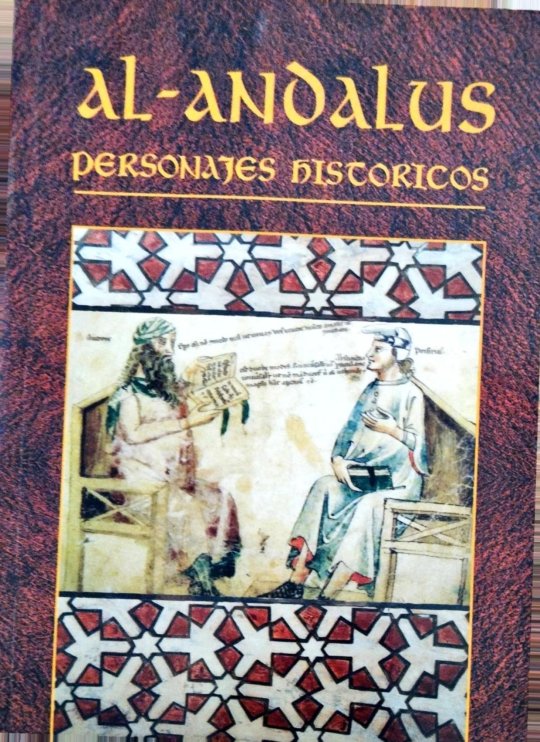
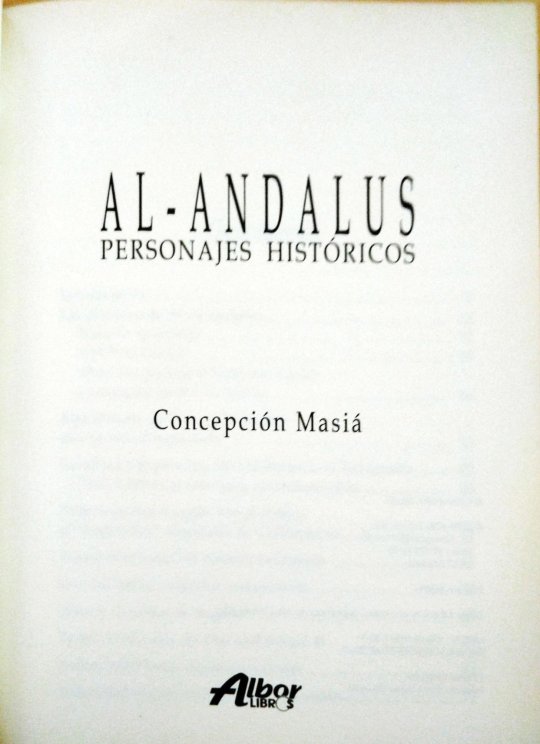

Summary
Introduction.................................. 9
The precursors of al-Andalus.....13
Count Don Julián....................13
Tarif ben Malluk. ....................15
Musa ben Nusayr and Tariq ben Ziyad: the conquerors of Spania...........16
Abd al-Aziz: a good governor with an unfortunate fate ..........................25
The Odyssey of Prince Abd al-Rahman the Immigrant......................................29
Abd al-Rahman was only twenty-five years old.........................................36
Sulayman ben Yaqzan ben al-Arabi: Charlemagne's deceived "deceiver" ........................... ...........41
Amrus ben Yusuf: the muladí of Huesca
.............................................................47
The “rabadies”: adventurous spirits.. ..............................................53
Ziryab: the singer of Baghdad........61
Tarub: the favorite of Abd al-Rahman II...............,...........................................67
Abbas ben Firnas: the first aviator............................ ......................73
Yahya ben Hakan al-Bakri: the miserly poet.....................................................77

Abd al Chabbar and Sulayman ben Martin: the rebels of Mérida..........................81
Eulogio and Álvaro de Córdoba:
pursuing martyrdom..........................85
The Andalusian Vikings..................... 95
The emir Abd Allah distrust and death...............................….................... 101
Musa ben Musa ben Qasi: the third king of Spain.......................................................107
Ibn Hafsun: the unredeemed rebel.....115
Abu Alí al-Sarrach: the Andalusian missionary. ...........................................125
Ibn Masarra: a freethinker in Spanish Islam.......,...........,...................................131
Abd al-Rahman III:
the first independent caliph of al-Andalus. ...........,................................137
Hasday ibn Shaprut:
the Jewish doctor of Abd al-Rahman III............ ....... ...................... ................... 145
Andalusians in France: the “Moorish kingdom” of Fraxinetum....................... 151
Rabbi ben Zayd: Bishop Recemundo............................................. 157
Al-Hakam al-Mustansir bi-llah:
passion for culture.................................. 161
Ibn Abd Rabbhi, the encyclopedist,
and Ibn Futais, the collector.................. 167
Al-Mansur “the Victorious” ...................171
Hisham II and Sanchuelo: misrule. .......191
Abu Muhammad Ali ibn Hazm:
The pigeon neackle................................209
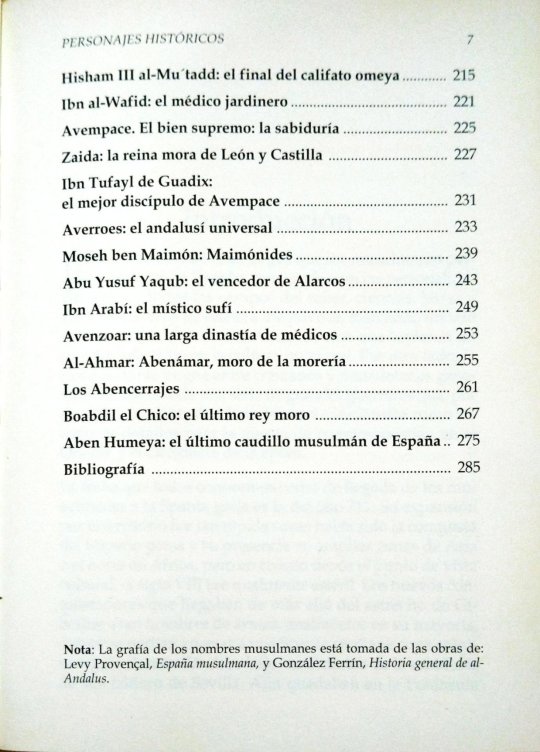
Hisham III al-Mu'tadd: the end of the Umayyad caliphate...............................215
Ibn al-Wafid: the gardener doctor.....221
Avempace. The supreme good: wisdom...................................................225
Zaida: the Moorish Queen of Leon and Castile........................................................227
Ibn Tufayl of Guadix:
the best disciple of Avempace................. ............................ .231
Averroes: the universal Andalusian....233
Moseh ben Maimon: Maimonides..... ..239
Abu Yusuf Yaqub: the winner of Alarcos......................................................243
Ibn Arabi: the Sufi mystic.....................249
Avenzoar: a long dynasty of doctors. ...................................................253
Al-Ahmar: Abenámar, Moor of the Morería. ...,...............................................255
The Abencerrajes. ..................................261
Boabdil the Younger: the last Moorish king ............................................................267
Aben Humeya: the last Muslim leader of Spain................ ..........................................275
Bibliography .............................................285
Note: The spelling of Muslim names is taken from the works of: Levy Provençal,
Muslim Spain, and González Ferrín, General History of al-Andalus.

Introduction
In the long eight hundred years that the Muslims remained in Spain, there were many personalities who, in all the fields of knowledge, sciences, letters and arts, stood out unequivocal, marking a milestone not only in the culture of al-Andalus, but that had a relevant character in universal culture.
On the other hand, the almost constant struggle between Christians and Muslims would also generate a whole series of great warriors who, for example, the infante Don Juan Manuel considered the best gifted for the war of all those who existed in the East and the West of their time.
The date that we all know as the arrival of the Muslims to Gothic Spania dates back to the year 711. Its expansion throughout the territory was so rapid as had been the conquest of the Persian empire and its presencein large areas of Asia or North Africa, but from a cultural point of view, the 8th century was totally sterile. The new conquerors who arrived from beyond the Strait of Gibraltar, were men at arms, mostly illiterate, who could do little contribute to a Christian Spania whose culture continued to develop under the dictates of the wisdom of Saint Isidore of Seville. Still they were left on the Peninsula
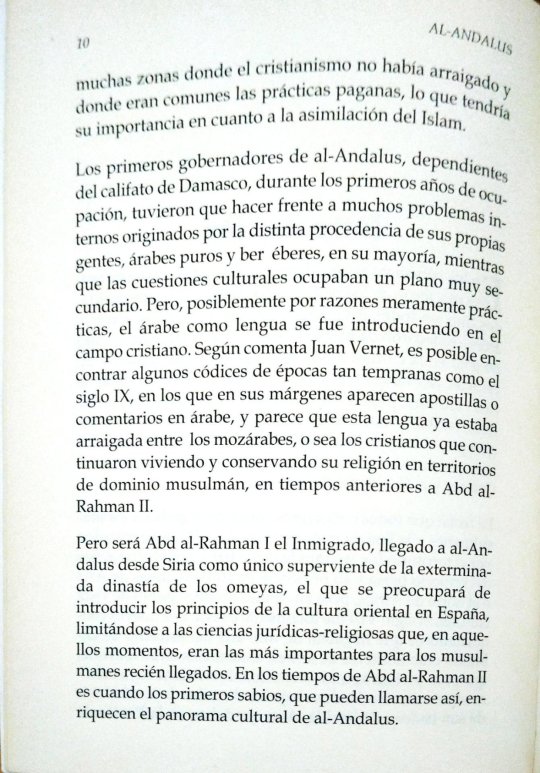
many areas where Christianity had not taken root and its importance regarding the assimilation of Islam.
The first governors of al-Andalus, dependent on Caliphate of Damascus, during the first years of occupation
had to face many enormous internal problems, originated by the different origins of their own people, Arabs
and berebers, mostly, while cultural issues occupied a very secondary level. But, possibly for purely practical reasons, Arabic as a language was introduced into the Christian field. According to Juan Vernet, it is possible to find
some codices from times as early as the 9th century, that in its margins appear apostilles or comments in Arabic,
and it seems that this language was already rooted among the Mozarabs,
that is, the Christians who continued to live and preserve their religion in Muslim-dominated territories, in times
before Abd al-Rahman II.
But it will be Abd al-Rahman I the Immigrant, who arrived in al-Andalus from Syria as the only survivor of the exterminated Umayyad dynasty, the one who will be concerned with introducing the principles of oriental culture in
Spain, limiting itself to the legal-religious sciences that, in those moments, were the most important for the newly Muslims
arrived. It was during the time of Abd al-Rahman II that the first wise men, who can be called that, enrich the cultural landscape of al-Andalus.

Poets, doctors, philosophers, mathematicians, geographers, undefeated generals...All of them will give al-Andalus and Europe a series of works that, by their importance will be translated, searched, accepted and will serve as a basis for the western culture and Renaissance ideas, in such a way that many of the great sages of the Italian Renaissance considered that all knowledge of the time came from Muslim Spain, which all the wise men were of Andalusian origin. And when the political decline and the disintegration of the caliphate, will not stop birth, grow and develop distinguished minds that will continue to maintain,for a long time, the prestige of al-Andalus. Curiously, this situation will be repeated throughout the history of Spain, when the Arab occupation just be a memory. The Spanish Golden Age will coincide with decadence of the Austrias, when the country loses its pre-ponderance in Europe, and with the disaster of '98, with the loss for Spain of its last colonies, will produce a cultural and scientific renaissance that has been called the Silver age.
Through the pages of this book we want to highlight those figures who occupied a predominant place in the history of al-Andalus, although not all of them were necessarily Muslims, since that in that cultured and tolerant al-Andalus, many Jews and some other Christians showed their genius, and of those who, often, we know more about his works than about his biography. But whatever religion they had, they were all, after all, Andalusians, born and raised in the extensive lands of al-Andalus. As a matter of curiosity we will include some groups of characters
anonymous people who, due to their surprising
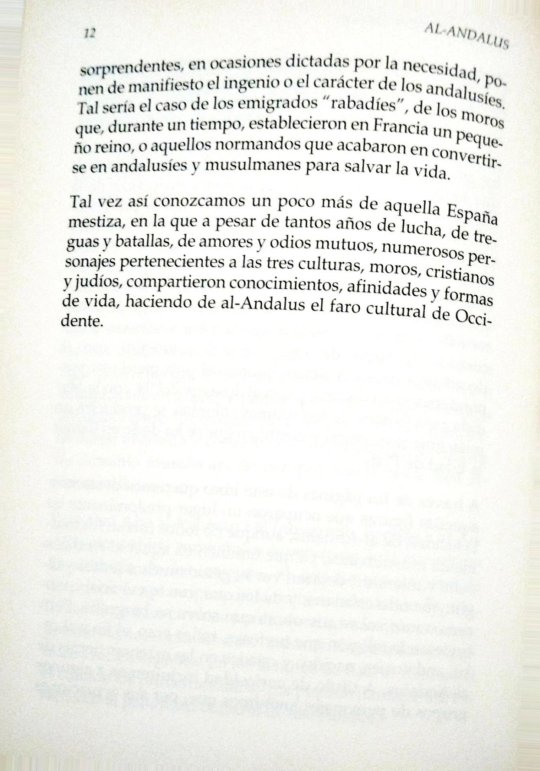
actions, on occasions dictated by necessity, they reveal the ingenuity or character of the Andalusians. Such would be the case of the "rabadíes", of the Moors who, for a time, established a small kingdom in France, or those Normans who ended up becoming Andalusians and Muslims to save their lives.
Perhaps this way we will learn a little more about that crossbred Spain, in which despite so many years of struggle, truces and battles, mutual loves and hates, numerous characters belonging to the three cultures, Moors, Christians and Jews shared knowledge, affinities and forms of
life, making al-Andalus the cultural beacon of the West.

The precursors of al-Andalus
Count Don Julián
The conquest of Morocco had been carried out quickly, but shallow. The Berbers were only subdued after a fierce resistance, defeated by an ambitious general who had just been appointed governor of Ifriqiya and Maghrib. His successes in these lands
They would prepare the ground for him to be the one to set his eyes and, also
his troops, over Gothic Spania. It was Musa ben Nusayr.
Musa, with the help of one of his sons, took possession of Tangier, and demanded that the subjugated tribes hostage to educate them in the new faith, which in turn, became propagandists of Islam, leaving in the conquered Morocco
Arab lieutenants, including General Tariq ben Ziyad, he turned to Ifriqiya. But it seems that the Ceuta square remained
in the hands of a Christian, the so-called Count Don Julián, who would have a
determining role in this entire story. We could consider it as a precursor of that al-Andalus that was about to be born.
#bookblr#book scans#historyblr#history books#al andalus#al andalus. personajes históricos#al andalus. historical figures#history#spanish history#musa ibn nusayr#tariq ibn ziyad#conde don julián#count don julián#count julian
26 notes
·
View notes
Text
Second part of the bookscans of Al Andalus. Historical Figures, here's the previous part
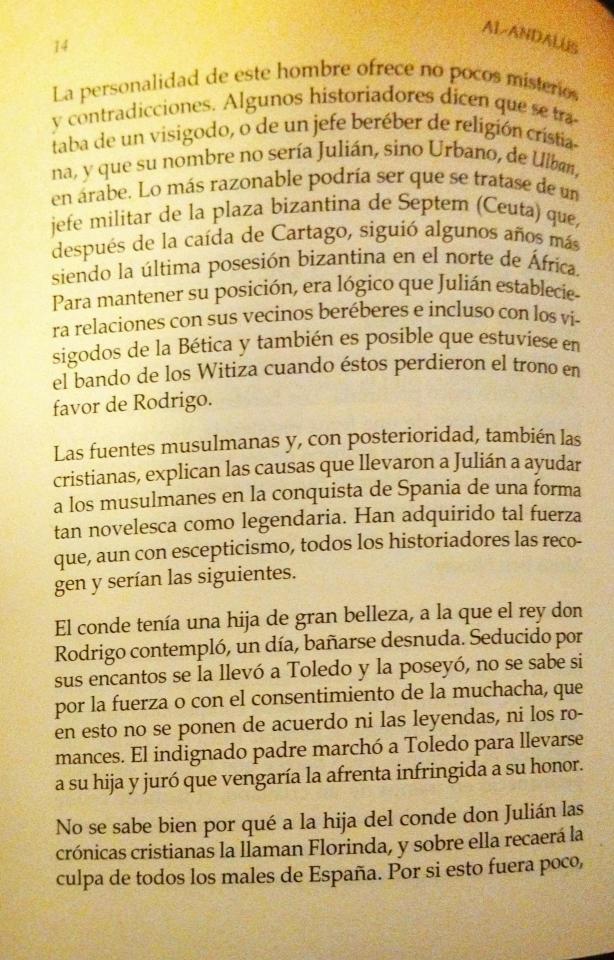
The personality of this man offers many mysteries and contradictions. Some historians say that he was a Visigoth, or a Berber of Christian religion, and that his name would not be Julián, but Urban, from Ulban, in Arabic. The most reasonable thing could be that he is a military commander from the Byzantine square of Septem (Ceuta) which, after the fall of Carthage, continued to be the last Byzantine position in North Africa for a few more years. To maintain his position, it was logical that Julián established relations with his Berber neighbors and even the Visigoths of Baetica and it is also possible that he was on the side of the Witizas when they lost the throne in favor of Rodrigo.
The Muslim sources and, later, also the
Christians, explain the causes that led Julián to help the Muslims in the conquest of Spania in such a way
novel as well as legendary. They have acquired such strength that, even
with skepticism, all historians collect them and they would be the following.
The count had a daughter of great beauty, whom the king Rodrigo, one day, contemplated her bathing naked. Seduced by her charms he took her to Toledo and possessed her, it is not known if because of force or with the consent of the girl, who in this neither legends nor romances agree. The indignant father marched to Toledo to take his daughter and swore
that he would avenge the affront inflicted on her honor.
It is not well known why the daughter of Count Don Julián is called Florinda in Christian chronicles, and on her will fall the
blame for all the ills of Spain. As if this were not enough,
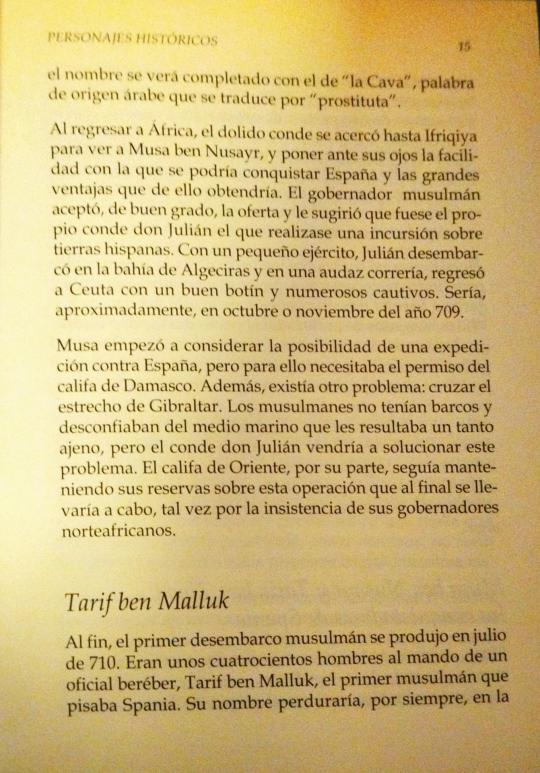
the name will be completed with “la Cava”, a word of Arabic origin which translates to "prostitute".
Upon returning to Africa, the hurt count went to Ifriqiya to see Musa ben Nusayr, and put before his eyes the ease with which one could conquer Spania and the great advantages that would be obtained from it. The Muslim governor willingly accepted the offer and suggested that it would be Count Don Julián himself who carried out an incursion onHispanic lands. With a small army, Julian landed in the bay of Algeciras and in a daring raid, he returned to Ceuta with good loot and numerous captives. It would be approximately October or November of the year 709.
Musa began to consider the possibility of an expedition against Spania, but for this he needed the permission of the Caliph of Damascus. In addition, there was another problem: crossing the Strait of Gibraltar. The Muslims did not have ships and distrusted the marine environment that they considered a bit strange, but Count Don Julián would come to solve this problem. The Caliph of the East, for his part, continued to maintain his reservations about this operation that would ultimately be carried out, perhaps because the insistence of their North African governors.
Tarif ben Malluk
Finally, the first Muslim landing occurred in July 710. There were about four hundred men under the command of a Berber officer, Tarif ben Malluk, the first Muslim to set foot in Spania. His name would last, forever, in the
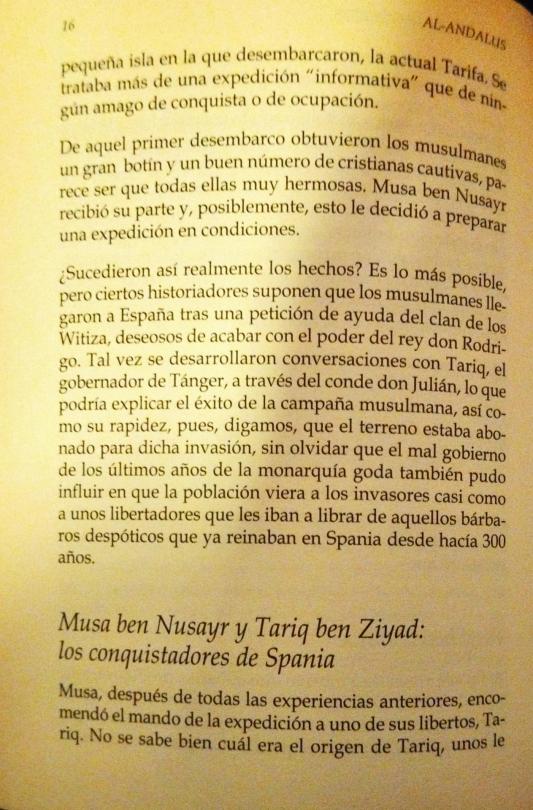
small island where they landed, the current Tarifa. It was more of an “informative” expedition than a threat of conquest or occupation.
From that first landing the Muslims obtained Muslims obtained a
great booty and a good number of captive Christian women, it seems to be
that all of them are very beautiful. Musa ben Nusayr received his part and, possibly, this decided him to prepare a proper expedition.
Did the events really happen like this? It is the most possible, butcertain historians suppose that the Muslims came to
Spania after a request for help from the Witiza clan, eager to put an end to the power of King Don Rodrigo. Maybe
conversations took place with Tariq, the governor of Tangier, through Count Don Julián, which could explain the
success of the Muslim campaign, as well as its speed, therefore, let's say that the ground was fertile for said invasion,
without forgetting that the bad government of the last years of the
Gothic monarchy could also influence the population to see the invaders almost as if they were liberators who were going to
rid of those despotic barbarians who already reigned in Spania for 300 years.
Musa ben Nusayr and Tariq ben Ziyad:
the conquerors of Spania
Musa, after all the previous experiences, entrusted the command of the expedition to one of his freedmen, Tariq.
It is not well known what Tariq's origin was, some
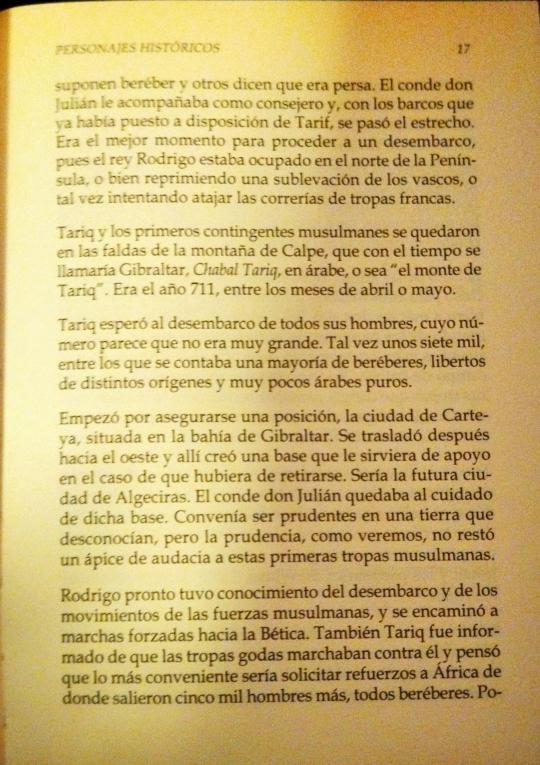
assume he was Berber and others say he was Persian. Count Don Julián
accompanied him as a counselor and, with the ships that he had already put to
Tarif's disposition, the strait was crossed. It was the best time to proceed to landing, since King Rodrigo was busy in the
north of the Peninsula, or repressing an uprising of the Basques, or perhaps trying to stop the raids of Frankish troops.
Tariq and the first Muslim contingents stayed in the foothills of the Calpe mountain, which in time would be called Gibraltar, Chabal Tariq, in Arabic, that is, “the mountain of Tariq.” It was the year 711,
between the months of April or May.
Tariq waited for all his men to disembark, whose number seems like it wasn't very big. Perhaps seven thousand, among whom the majority were Berbers, freedmen of different origins and
very few pure Arabs.
He began by securing a position, the city of Carteya, located in the bay of Gibraltar. He then moved west and there created
a base that would serve as support in the event that it had to backing out. It would be the future city of Algeciras. Count Don Julián was in the care of said base. It was advisable to be cautious in a
land that they did not know, but prudence, as we will see, did not took less audacity to these first Muslim troops.
Rodrigo soon learned of the landing and the movements of the Muslim forces, and set out on marches forced towards Baetica. Tariq was also informed that the
Gothic troops were marching against him and he thought that the most convenient
would be to request reinforcements from Africa where five thousand men came from
more, all Berbers. Po-
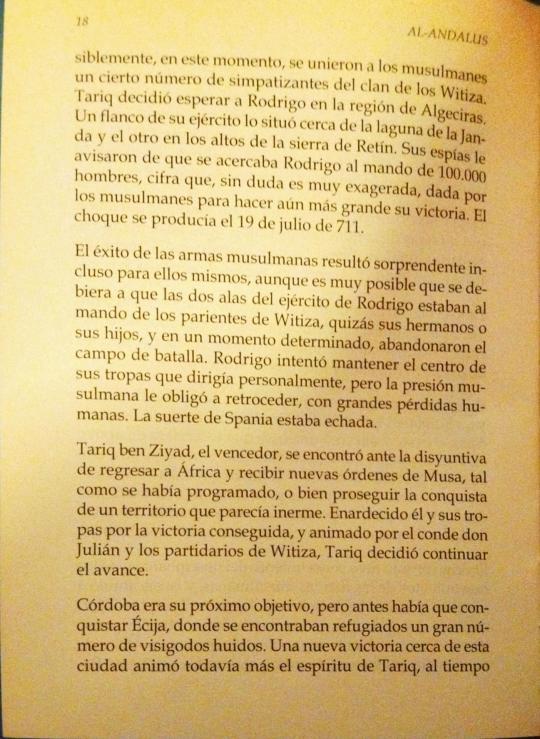
ssibly, at this time, the Muslims were joined by a certain number of sympathizers of the Witiza clan. Tariq decided
wait for Rodrigo in the region of Algeciras. One flank of his army was placed near the Janda lagoon and the other on the heights of the Retín mountain range. His spies warned him that Rodrigo was approaching
commanding 100,000 men, a figure that is undoubtedly very exaggerated, given by the Muslims to make even bigger their victory. The clash occurred on July 19, 711.
The success of Muslim weapons was surprising even for themselves, although it is very possible that it was because
the two wings of Rodrigo's army were commanded by the relatives of Witiza, perhaps his brothers or his children, and in a certain moment, they left the battlefield. Rodrigo tried to hold the center of his troops that he led personally, but Muslim pressure forced him to retreat,
with great human losses. Spania's luck was
cast.
Tariq ben Ziyad, the victor, found himself faced with the dilemma of returning to Africa and receiving new orders from Musa, as had been scheduled, or continuing the conquest of a territory that seemed defenseless. He and his troops were enraged by the victory achieved, and encouraged by Count Don Julián and Witiza's supporters, Tariq decided to continue the advance.
Córdoba was their next objective, but first they had to conquer Écija, where a large number of escaped Visigoths were taking refuge. A new victory near this city encouraged Tariq's spirit even more, while
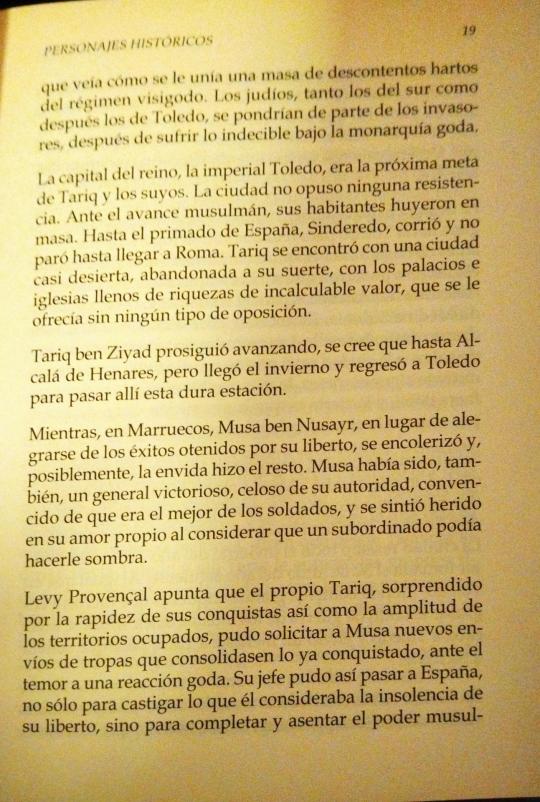
he saw how he was joined by a mass of dissatisfied people fed up with the Visigothic regime. The Jews, both those of the south and later those of Toledo, would side with the invaders, after suffering the unspeakable under the Gothic monarchy.
The capital of the kingdom, the imperial Toledo, was the next goal of Tariq and his people. The city did not put up any resistance. Faced with the Muslim advance, its inhabitants fled. Even the primate of Spania, Sinderedo, ran away and did not stop until he reached Rome. Tariq found an almost deserted city, abandoned to its fate, with palaces and churches full of riches of incalculable value, which were offered to him without any type of opposition.
Tariq ben Ziyad continued advancing, it is believed as far as Alcalá de Henares, but winter arrived and he returned to Toledo to spend this hard season there.
Meanwhile, in Morocco, Musa ben Nusayr, instead of rejoicing at the successes achieved by his freedman, became angry and, possibly, envy did the rest. Musa had also been a victorious general, jealous of his authority, convinced that he was the best of soldiers, and he felt hurt in his self-esteem when he considered that a subordinate could overshadow him.
Levy Provençal points out that Tariq himself, surprised by the speed of his conquests as well as the breadth of the occupied territories, was able to request new shipments of troops from Musa to consolidate what had already been conquered, fearing a Gothic reaction. His leader was thus able to go to Spania, not only to punish what he considered the insolence of his freedman, but to complete and establish Mus-
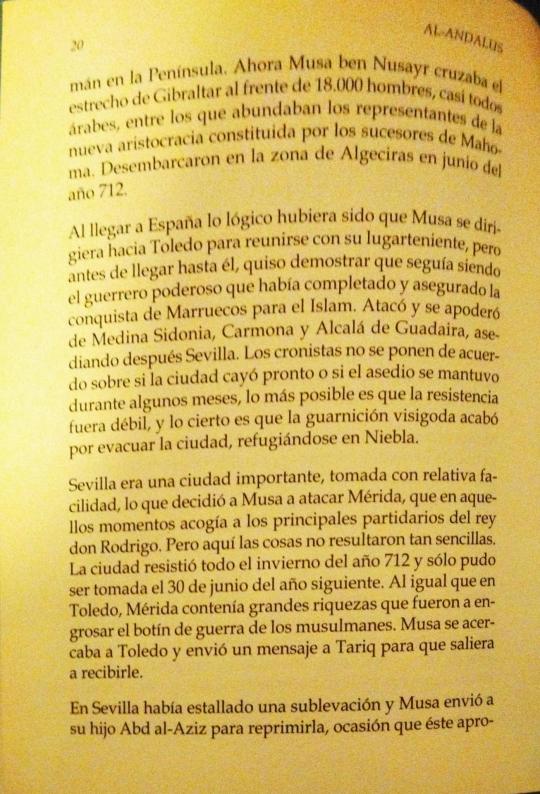
lim power on the Peninsula. Now Musa ben Nusayr crossed the Strait of Gibraltar at the head of 18,000 men, almost all Arabs, among whom were many representatives of the new aristocracy formed by the successors of Muhammad. They landed in the area of Algeciras in June of the year 712.
Upon arriving in Spania, it would have been logical for Musa to head towards Toledo to meet with his lieutenant, but before reaching him, he wanted to demonstrate that he was still the powerful warrior who had completed and ensured the conquest of Morocco for Islam. He attacked and took control of Medina Sidonia, Carmona and Alcalá de Guadaira, later besieging Seville. The chroniclers do not agree on whether the city fell soon or if the siege continued for a few months; it is most likely that the resistance was weak, and the truth is that the Visigoth garrison ended up evacuating the city, taking refuge in Niebla.
Seville was an important city, taken with relative ease, which decided Musa to attack Mérida, which at that time hosted the main supporters of King Don Rodrigo. But here things were not so simple. The city resisted throughout the winter of 712 and could only be taken on June 30 of the following year. As in Toledo, Mérida contained great riches that added to the war loot of the Muslims. Musa was approaching Toledo and sent a message to Tariq to come out to meet him.
An uprising had broken out in Seville and Musa sent his son Abd al-Aziz to suppress it, an opportunity that he took advantage
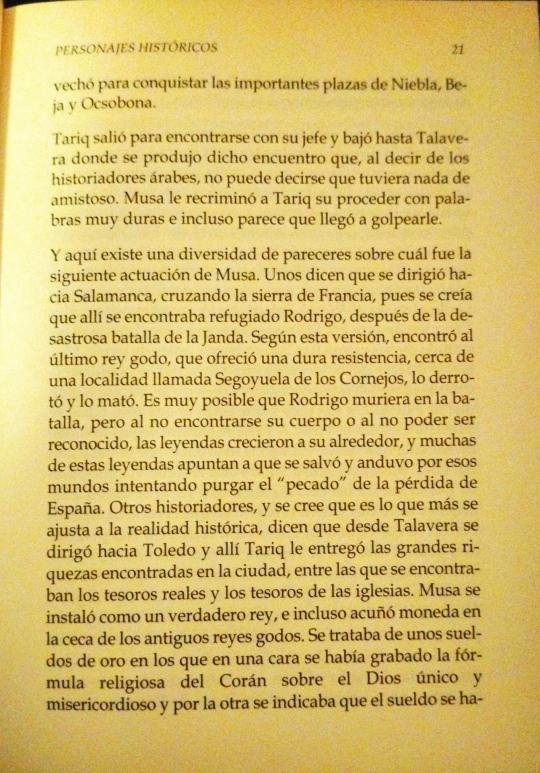
to conquer the important squares of Niebla, Beja and Ocsobona.
Tariq left to meet his boss and went down to Talavera where this meeting took place which, according to Arab historians, cannot be said to have had anything friendly. Musa reproached Tariq for his behavior with very harsh words and it seems that he even hit him.
And here there is a diversity of opinions about what Musa's next performance was. Some say that he headed towards Salamanca, crossing the Sierra de Francia, since it was believed that Rodrigo was taking refuge there after the disastrous battle of La Janda. According to this version, he found the last Gothic king, who offered tough resistance, near a town called Segoyuela de los Cornejos, defeated him and killed him. It is very possible that Rodrigo died in battle, but since his body was not found or could not be recognized, legends grew around him, and many of these legends suggest that he was saved and walked through those worlds trying to purge the “sin” of the loss of Spania. Other historians, and it is believed that this is what most closely corresponds to historical reality, say that from Talavera he headed towards Toledo and there Tariq gave him the great riches found in the city, among which were the treasures royals and the treasures of the churches. Musa installed himself as a true king, and even minted coins in the mint of the ancient Gothic kings. They were golden salaries on which the religious formula of the Koran about the only and merciful God had been engraved on one side and on the other it indicated that the salary had been
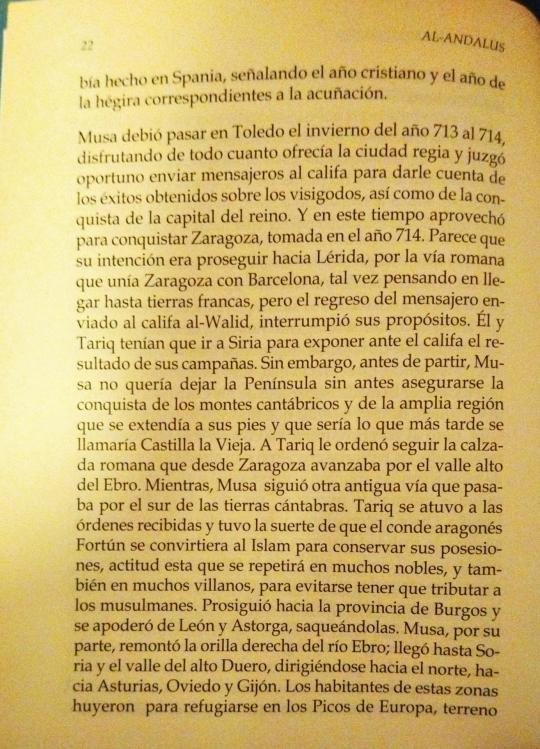
made in Spania, indicating the Christian year and the year of the hegira corresponding to the coinage.
Musa had to spend the winter from 713 to 714 in Toledo, enjoying everything that the royal city offered and considered it appropriate to send messengers to the caliph to inform him of the successes obtained against the Visigoths, as well as the conquest of the capital of the Kingdom. And at this time he took the opportunity to conquer Zaragoza, taken in the year 714. It seems that his intention was to continue towards Lleida, along the Roman road that linked Zaragoza with Barcelona, perhaps thinking of reaching Frankish lands, but when the messenger returned sent to the caliph al-Walid, interrupted his purposes. He and Tariq had to travel to Syria to present the results of their campaigns to the caliph. However, before leaving, Musa did not want to leave the Peninsula without first securing the conquest of the Cantabrian Mountains and the wide region that extended at its feet and which would later be called Old Castile. Tariq was ordered to follow the Roman road that advanced from Zaragoza through the upper Ebro valley. Meanwhile, Musa followed another ancient route that passed through the south of the Cantabrian lands. Tariq followed the orders he received and was lucky that the Aragonese count Fortún converted to Islam to preserve his possessions, an attitude that was repeated by many nobles, and also by many villains, so as not to have to pay taxes to Muslims. He continued towards the province of Burgos and took control of León and Astorga, plundering them. Musa, for his part, went up the right bank of the Ebro River; He reached Soria and the upper Duero valley, heading north towards Asturias, Oviedo and Gijón. The inhabitants of these areas fled to take refuge in the Picos de Europa mountain range, terrain
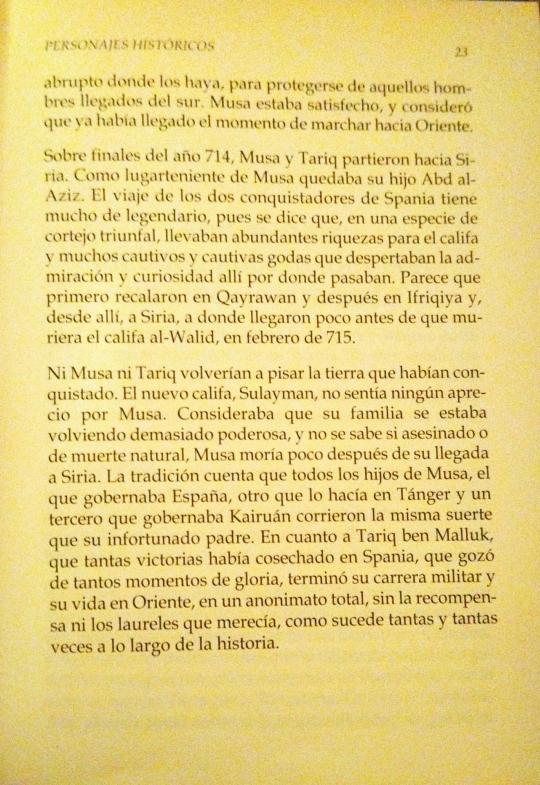
very abrupt, to protect themselves from those men arriving from the south. Musa was satisfied, and considered that the time had come to march towards the East.
Around the end of the year 714, Musa and Tariq left for Syria. Musa's lieutenant was his son Abd al-Aziz. The journey of the two conquerors of Spania is very legendary, since it is said that, in a kind of triumphal procession, they brought abundant riches for the caliph and many Gothic captives who aroused admiration and curiosity wherever they passed. It seems that they first landed in Qayrawan and then in Ifriqiya and, from there, to Syria, where they arrived shortly before the death of the Caliph al-Walid, in February 715.
Neither Musa nor Tariq would return to set foot on the land they had conquered. The new caliph, Sulayman, had no appreciation for Musa. He considered that his family was becoming too powerful, and it is not known whether murdered or a natural death, Musa died shortly after his arrival in Syria. Tradition says that all of Musa's sons, the one who ruled Spania, another who ruled in Tangier and a third who ruled Kairouan, suffered the same fate as their unfortunate father. As for Tarif ben Malluk, who had won so many victories in Spania, who enjoyed so many moments of glory, he ended his military career and his life in the East, in total anonymity, without the reward or laurels he deserved, as happens so many times throughout history.
#bookblr#historyblr#al andalus#al andalus. historical figures#al-andalus. personajes históricos#al andalus history#book scans#the conquest of al-andalus#fath al andalus#la conquista de al andalus#tariq ibn ziyad#musa ibn nusayr#tarif ibn malik#conde don julián#count don julián#julián de ceuta#spanish history
10 notes
·
View notes
Text
c. 711, colorized

Sorry I had to do this meme (btw, here's a medieval depiction of Tariq ibn Ziyad):

#memes#history memes#historyblr#al andalus#conde don julián#tariq ibn ziyad#musa ibn nusayr#tarif ibn malik#711#count don julián#count julian#julián de ceuta
8 notes
·
View notes
Text
Recently I have found a period drama about Tariq ibn Ziyad and the conquest of the Iberian Peninsula, so I thought it's an appropiate to share it now because of the bookscans of AL-ANDALUS. Historical figures. This period drama is a Kuwaiti-Syrian series from 2022, Fath Al-Andalus (The Conquest of Al Andalus), that has 30 episodes so far.
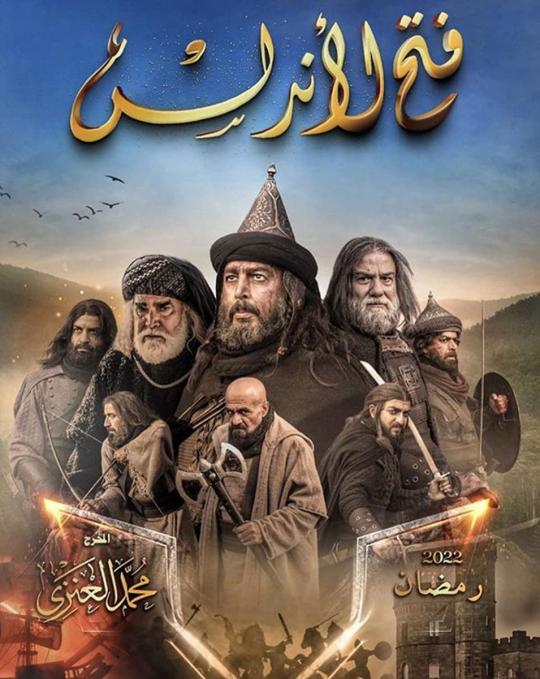

(There are ships on fire on the second poster, maybe in the series there's a scene or a reference about the legend of Tariq burning the ships after arriving to the Iberian Peninsula?)
I haven't watch it (yet), but in YouTube there's a watch list of the 30 episodes with subtitles.
As far as I know there has been controversies about this series in Morocco due to some historical inaccuracies, like erasing Tariq's Amazigh origins and undervalue the role of the Amazigh people in the conquest of Al Andalus.
Main cast
Suhail Jabei as Tariq ibn Ziyad
Taiseer Edris as Rodrigo, King of the Goths
Rafik Ali Ahmad as Musa ibn Nusayr
Pierre Dahger as Julián, Count of Ceuta
Marah Hijaz as Princess Florinda
Akef Najem as Abu Basir, the Judge
Creative and technical staff
Directors: Mohammad Alenezi and Saleh El Salty
Cinematography: Dragan Sisa
Editor: Mohamed Rageh
Visual effects: Momen Ebba and Eman Alshehabi
Productor: Al Buraq Production
Music: Nouamane Laholu

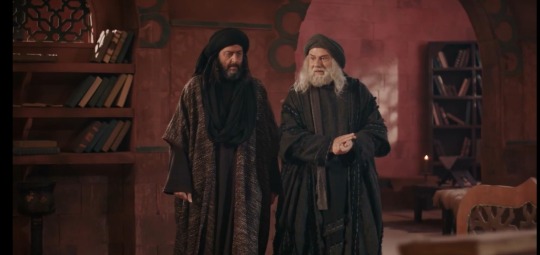

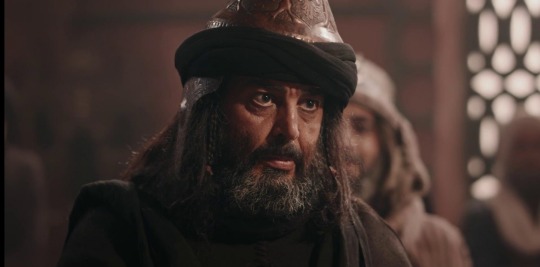


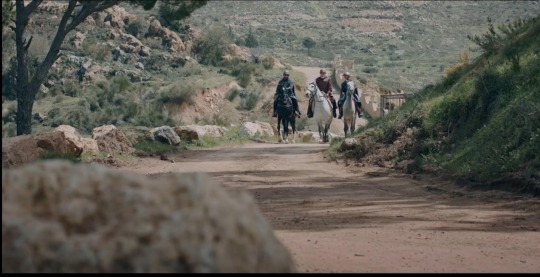

#fath al andalus#period dramas#the conquest of al andalus#series#tariq ibn ziyad#king rodrigo#musa ibn nusayr#conde don Julián#count don julián#julián de ceuta#rey rodrigo#florinda#princess florinda#abu basir#suhail jabei#taiseer edris#rafik ali ahmad#pierre dahger#marah hijaz#akef najem#al andalus#mohammad alenezi#dragan sisa#mohamed rageh#momen ebba#eman alshehabi#nouamane laholu#book scans related
4 notes
·
View notes